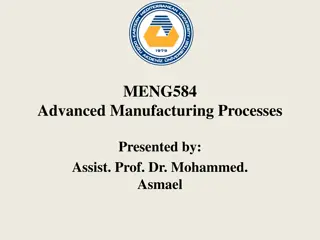Machine Shop Safety and Best Practices for Precision Machining
Safety is paramount in the machine shop. Ensure proper safety measures like wearing safety glasses, appropriate clothing, and using guards on machines. Precision measuring tools must be calibrated and used correctly for accurate results. Machine setups require rigidity and proper tools for efficient operations. Follow specific guidelines for machining to achieve quality finishes and prevent accidents.
Download Presentation

Please find below an Image/Link to download the presentation.
The content on the website is provided AS IS for your information and personal use only. It may not be sold, licensed, or shared on other websites without obtaining consent from the author.If you encounter any issues during the download, it is possible that the publisher has removed the file from their server.
You are allowed to download the files provided on this website for personal or commercial use, subject to the condition that they are used lawfully. All files are the property of their respective owners.
The content on the website is provided AS IS for your information and personal use only. It may not be sold, licensed, or shared on other websites without obtaining consent from the author.
E N D
Presentation Transcript
EASA ELECTRO MECHANICAL AUTHORITY SOUTEAST CHAPTER CONFERENCE 2021 MYRTLE BEACH SC
SAFETY The most important piece of safety equipment in the machine shop is safety glasses. It is recommended to wear a short sleeve shirt while working around moving equipment. If you are wearing long sleeves you must have your sleeves rolled up. All shirts should be tucked in to prevent shirt tails from being pulled into moving equipment. All guards must be in place before operating a machine. Always use a brush to remove dust or chips from a machine, never your hand. Improper lifting can cause permanent injury to the back. When lifting heavy objects, you must always keep your back straight and lift with your legs. Material that is long or weighs over 40 lbs. must be carried by two people, one on each end. Never wear gloves while operating rotating equipment Files must have a handle covering tang if using on machine
PRECISION MEASURING Anyone doing machine work is only as good as the measuring instrument they are using Measuring instruments must be cared for, cleaned, and maintained All measuring instruments must be calibrated with standards or gage blocks Always use the appropriate measuring instrument. A dial caliper is fine if your tolerance is + or 0.003. If the tolerance is tighter than + or 0.003 a micrometer must be used.
MACHINE SETUPS RIGIDITY IS A MUST Lathe 3 jaw chucks (self centering, use oversize material) Milling Machine (Tram head) Vice 4 jaw chuck (independent jaws needs indicating) Table Clamping Vee Blocks 5 C collet holder Rotary Table Face plate Custom fixturing Tailstock (live/dead centers) Steady or follower rests
GENERAL MACHINING INFORMATION Always sneak up on a finish size. If you have 0.100 to remove, rough off 0.080 and then increase RPM 20% decrease feed 20% and take 0.012 to 0.015 on first finish pass. Measure and then take remaining amount minus 0.001-0.002 until proficient. To reduce chatter, increase feed decrease speed 15-20% incrementally It is always more rigid to turn towards the headstock on a lathe if possible. This is not always possible. Always try to have turning tool on center while turning on the lathe Do not take large cuts on a milling machine while climb milling. The cutter rotation will pull the cutter into the part and often overcut. Use power feed when possible. Be aware of tool deflection and pressure while cutting on any machine If speeds and feeds are correct no cutting fluid is needed unless deep drilling, threading, or tapping. Cutting fluid will give you a better surface finish most times
GENERAL MACHINING INFO CONTINUED If squaring round stock in a milling machine vice, roll machined surface to solid jaw and use a small round rod (Like tig wire) on the movable jaw to verify part is seated on vice base or parallels and solid jaw. Round rod will allow part to shift as needed to accomplish this on movable jaw Always stone milling machine vice jaws and parallels to make sure you have no burrs, so parts sit flat and square Always deburr parts with file or stone (unless print specifies sharp edge). If sharp edge is requested, a small piece of brass rod will remove burrs if pushed on sharp edge and leave sharp. Burrs show lack of quality/ownership and is a safety hazard Never stop a machine while cutting tool is in contact with part unless emergency arises
SPEEDS Lathe (Safety should override calculated speed) Milling Machine RPM=Cutting speed x 4 / diameter of part (Cutting speed is how far a part will travel in one minute) (CS should be multiplied by 300% when using carbide tool) RPM=CS x 4 / diameter of tool (CS should be multiplied by 300% when using carbide tool) Mild steel 80 Tool steel 50 Mild steel 80 Aluminum 160 Tool steel 50 Brass 120 Aluminum 160 Brass 120
FEEDS Milling Machine (Inches per minute or feed per tooth per revolution) Lathe IPM=FTR x T x RPM (to find feed per minute=feed per tooth per rev x number of teeth or flutes x rpm) Never feed less than 0.001 per tooth per rev. Most endmills feed 0.003 to 0.01 feed per tooth while a face or shell mill usually feed 0.007 to 0.02 per tooth Standard roughing feed rate for the lathe (starting point) is 0.010 feed per revolution Standard finishing feed rate for the lathe (starting point) is 0.002 0.008 feed per revolution. More tool contact surface area will require operator to reduce RPM (HSS cutoff tool, grooving tool, and etc.) Always rough while conventional milling (cutter rotation turns into feed direction, plunges) Finish mill while climb milling (cutter rotation turns or pulls into part while feeding)
CUTTING TOOLS - HIGH SPEED STEEL, COBALT, AND CARBIDE Lathe (Right hand tool cuts to the left. Left hand tool cuts to the right) HSS is most common. Can be ground into any shape to meet need. Use cutting speed of 80 Cobalt can be used when added strength and durability is needed. Can be ground to any needed shape or form (CS can be increased 10 to 20% over HSS) Carbide is the most common advanced tool material. Need to verify grade meets applications as the harder grades will not last on interrupted cuts. Manufacturer will specify speeds and feeds as substrates and coatings can change characteristics. Polycrystalline cubic boron nitride (PCBN) more durable and harder than carbide. Expensive Diamond (polycrystalline diamond PCD) hardest but cannot hold up to interrupted cuts. Expensive
CUTTING TOOLS HIGH SPEED STEEL, COBALT, AND CARBIDE Milling Machine (Endmills, drills, machine reamers and face mills are usually right-hand rotation cutters. Rotation will dictate conventional and climb milling direction) Must have center cutting endmill to plunge cut unless you can implement a helical entry (CNC) Two flute endmills most common and cheaper. Four flute endmills give better finish (verify feedrate) Most jobber drill bits are 118*. Screw machine drill bits (usually short) are 135* and will drill harder materials. Always center drill first for accuracy of hole placement. Center drill should never penetrate farther than 2/3 of large taper on center drill. If drilling large holes, it is often beneficial to lead or step drill to get to final size When drilling hole for reaming, always drill hole 1/64 (0.0156) of an inch under finish hole size
CUTTING TOOLS CONTINUED Cutting tools must have a leading/cutting edge and clearance behind it to keep from rubbing and causing tool push off. Positive rake tools require less horsepower to cut but cutting edge will wear quicker. Negative rake tools require more machine horsepower but will extend the life of the cutting edge When sharpening a tool, grind relief until the relief meets cutting edge. Never grind cutting edge first I prefer setting up a lathe tool where I can square a shoulder off but when a tool is angled into the direction of the cut, the tool can slip and rotate which will dig into part. Set up rigidity is key to any machine operation A part can stick out of chuck on a lathe three times the diameter without being supported. If stick out requirement is more than three times the diameter, a tailstock, and/or steady rest must be used
CUTTING TOOLS CONTINUED The less profile a tool has, the stronger the tool will be. Therefore, a roughing tool should appear more square and bulkier than a finish tool. For an example, an appropriate advanced carbide roughing tool is an 80* diamond inserted tool and an appropriate finishing tool is either a 55* or 35* degree diamond which will allow them to get into tighter spots to profile if needed. Finish tools rarely take a cut deeper than the TNR or tool nose radius, often 1/32 or around 0.030 max.
TOLERANCES/QUALITY Inspection should always take place before a part or component leaves machine. It is hard to relocate a machined part to exactly where it was Verify measuring instruments are calibrated Verify tolerances/dimensions before you start and plan your attack. Have a defined approach to completion Every part machined represents the quality of your business Use your tolerance. If have + or 0.005, your part does not need to be + or 0.0002
THANK YOU/QUESTIONS BRANDON HASELDEN BRANDON.HASELDEN@HGTC.EDU























